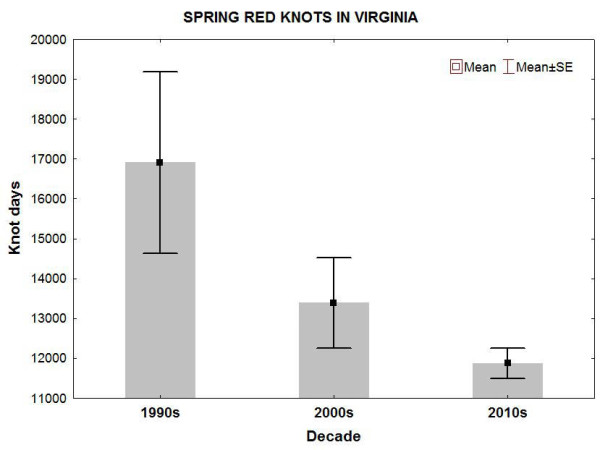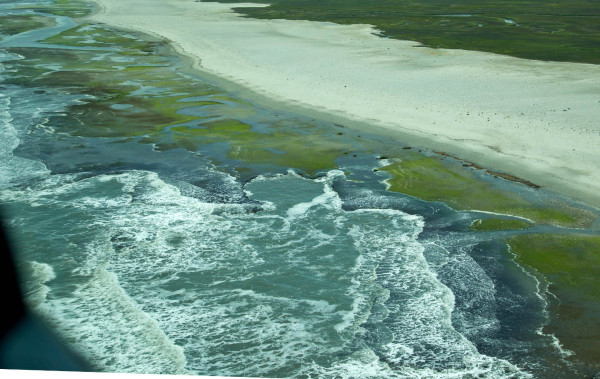Red knot decline spreads to Virginia
Grace Flies East Along James River Aug 25
August 26, 2014Camellia Returns to Saint Julian Creek 8/28
August 29, 2014
The rufa subspecies of the red knot has experienced a dramatic decline over the past three decades. Evidence of the decline has come from long-term population assessments and surveys of both a major spring staging area, Delaware Bay, and the largest known overwintering site, Tierra del Fuego. The decline has led to its listing as an endangered population in Canada, its declaration of endangerment by the Convention on the Conservation of Migratory Species, and a recent proposed rule change to the United States Fish and Wildlife Service to include the population on the list of threatened and endangered wildlife.

Red knot staging in Virginia. Photo by Bryan Watts.
Prior to this year, one of the conundrums in the broader decline of rufa knots has been the stronghold of the Virginia Barrier Islands. Despite being less than 100 kilometers south of Delaware Bay, declines in staging red knots had not been documented in Virginia. Long-term aerial surveys of the islands conducted by Bryan Watts of CCB and Barry Truitt of The Nature Conservancy had not detected a statistically significant trend in use. However, following the compilation of the 2014 surveys, this pattern has changed. With the addition of the 2014 surveys, an examination of “knot days”, an index of seasonal use of the islands, has revealed a significant decline across decades.

Graph of mean “knot days” across three decades. Data from Bryan Watts and Barry Truitt.
Most of the early explanations forwarded to explain the decline in the rufa population focused on spring foraging conditions within Delaware Bay, where estimates of staging birds have declined by 60-80%. Red knots using Delaware Bay depend almost exclusively on eggs from spawning horseshoe crabs to replenish fat reserves before making their final flight to arctic breeding grounds. Commercial overharvest of horseshoe crabs has been suggested as a driver of observed declines. Unlike Delaware Bay to the north, the Virginia Barrier Islands do not support significant horseshoe crab spawning events. In Virginia, staging red knots depend on clams and mussels to build fat reserves. If early explanations for the decline are correct and the prey conditions within mid-Atlantic staging sites are the root cause of declines, then declines in Virginia may raise concerns for the local clam and mussel populations. If the primary cause of declines resides elsewhere, such as arctic breeding grounds, then trends within staging areas may only reflect conditions in these other locations. The most likely scenario is that the population is experiencing multiple stressors throughout its annual cycle.

Spat of the blue mussel on intertidal peat along Cedar Island in Virginia. The developing spat has a characteristic blue tone from the air. In many years this is the primary prey of red knots staging on the Virginia barrier islands. Photo by Bryan Watts.
Written by Bryan Watts | bdwatt@wm.edu | (757) 221-2247
August 27, 2014



